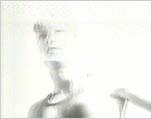Sex in the Ice Cubes
Subliminal messages--once a myth--are now routine.

In 1957, a PR agent named James Vicary announced that he had instigated long lines at a New Jersey movie theater concession stand by flashing split-second messages like "Hungry? Eat popcorn" and "Drink Coke" on the screen. Although Vicary almost certainly fabricated the story, it entered the popular imagination as a settled fact. Then, in the 1970s, a professor of communication studies named Wilson Bryan Key made his own set of announcements. Key wrote such books as Subliminal Seduction and Media Sexploitation, books in which he claimed to have found a man with an erection in the Camel cigarettes logo and the word "sex" in the ice cubes in liquor ads. But his claims couldn't be confirmed either. It was impossible to tell which shapes were messages and which just shapes.
Scholars dismissed these popular myths. But they did acknowledge that, in theory, sounds at certain decibels and images flashed at high speeds could influence the brain without our knowing it. Video clips lasting between two-thirtieths and three-thirtieths of one second--two or three frames--will sometimes fall into that category. The 1980 film Cruising actually did splice shots of what looked like gay sex into murder scenes, insinuating into the mind of the audience the killer's equation of homosexual penetration with stabbing. But that was rare.
Today, bursts of images lasting one to three frames--like the ones in Cruising--appear regularly in advertisements for sneakers, TV shows, software companies, colas, even mutual funds. Scientifically recognized subliminal messages are in fact now a part of our everyday lives. The use of real subliminals began in the early '80s, when video editors at MTV decided that two minutes was too long to be watching men in leather pants thrust and prance. For the sake of variety, they invented MTV's helter-skelter style of quick video bursts. The frenetic editing was aided by the invention of a machine, called "Avid," that digitized film images, allowing editors to do their cutting and pasting on computer screens rather than on long, curling rolls of film. In 1990, MTV first aired Buzz, a show that pulsated with long strings of quick cuts run under spoken reflections on time, speed, and even quick cuts themselves; by then, says director Mark Pellington, editors were "just punching images into the machines, to see how fast we could get them to go."
Advertisers began to imitate the MTV style. One example: an ad for Reebok sneakers and Lady Foot Locker in which women play softball, go rock climbing, score a soccer goal. While a woman recovers from what was evidently an exhausting run--she is bent over, hands on knees, sweaty hair hanging down--there is a flash of light. We see her stretching. The casual viewer sees nothing in the flash. Only to someone clicking frame by frame is it clear that the flash contains the image of that same woman standing peacefully, placidly, confidently, gazing into the distance. The woman is on the screen in this position for two frames, and then she is gone.
A nother ad, for NBC's The Pretender, contains a flurry of images. It consists of two frames of a sign saying "Wall Street," two frames of a man sitting behind a desk, and two frames of a Greek statue. None of this is apparent when viewing the ad at normal speed.
And then there is an ad for the Microsoft Network that shows a scrolling computer screen--each stage of which is on for no more than two frames--offering the following mini-manifesto:
The Bill of Rights is the foundation on which our nation is built. The Internet is an enormously valuable place in which those rights must continue to thrive. Both the Bill of Rights and the Internet are potentially fragile. Mess with either of them too much, and we might ruin them. We can't let this happen. ... The Internet's potential is enormous, and the stakes are high. The Internet can raise the quality of political debate, the quality of education, the quality of life. It is precious and important, and we must not take it for granted.

The creators of the Reebok ad say they were just shooting for "interesting texture." The woman who cut the ad for The Pretender, a show about a man with strange powers, hoped her sequence would make the show look "mysterious." Lucas Eskin, who edited the MSN ad for Wieden & Kennedy, suggested quick cuts were one of the few ways in which a computer screen could be made to look exciting. "Quick cuts can make anything look interesting," Eskin says. "You take a woman and flash her quickly and, whammo, she's more beautiful, more alluring."
The modern subliminal appears, in short, benign. The older ones seemed out of place: The ad is for whiskey, one might have asked, so why are there tits in the ice cubes? But the images in today's ads seem to belong. In fact, they don't seem to be messages at all. They seem to be just pictures, like the rest of the pictures in the ad.
But how does advertising today achieve its end? Not through explicit instructions but through hazy moods built from compelling product shots, insinuating copy, and beguiling music; through the color of a dress and the tone of a voice; through indirection. The ultimate message of any set of frames is no different--just as vague, just as persuasive, as the message of the ad itself: Buy our product. The difference is that if the frames are subliminal, the message gets across faster--and maybe reaches deeper--than when they aren't.
Professor John Bargh, a research psychologist at New York University, thinks subliminal sequences are not just interesting video effects but also powerful influences on behavior. In one experiment Bargh conducted, people who had been flashed such words as "elderly," "Florida," and "gray" walked more slowly than others who were spared this treatment. In another, white subjects were flashed a human image before hearing someone recount a morally ambiguous tale. Subjects who were flashed a black man's picture were more likely to regard the narrator of the story as hostile than were those who glimpsed a white man's face.
The few frames within the Reebok ad, Bargh says, make the tortured runner look triumphant. What's more, the second time we see the runner, she appears familiar and, because familiar, nice. The ad for The Pretender might indeed stimulate a sense of "wonder" by employing the images of money, power, and mythology in such a way that one can sense but not quite comprehend them. As for the Microsoft ad, the reference to the Bill of Rights might resonate subliminally with the overall message of the ad, which portrays the Internet as a cheap and easy way to communicate with other people, a modern-day public square. These images aren't part of some insidious mind-control technique; they don't, as we might fear, make the viewer buy the product being presented. But they may, in ways we don't detect, encourage it.
Perhaps the main difference between the present era and earlier ones is that today we feel different about such encouragement. The older subliminal "scholarship" suggested, at bottom, that advertising itself was a perversion--of which the subliminal message was just a particularly lurid example. But times have changed: Today capitalism and consumer culture are triumphant around the globe, consumers think themselves hip to corporate wiles, and the idea of a mind completely free from the secret seductions of commerce seems unrealistic and maybe not even particularly desirable. In such a context, the message of advertising--buy our product--and the most artful techniques used to promote it aren't considered threatening. They are, for better or worse, business as usual.